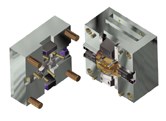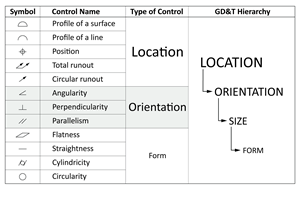Getting the Most Bang for Your Buck!
An innovative software package takes you from concept to product more quickly than ever.
A new hybrid solid/surface parametric CAD system with full drafting capabilities has decreased mold design time by up to 90 percent and yields greater productivity while saving money. This software package - called TopMold - is actually a module of the TopSolid software package from Clear Cut Solutions (Addison, IL) - a software distributor.
This system eliminates the need to purchase several systems to accomplish a project from beginning to end, according to Clear Cut Solutions President Bill Genc. There are several modules designed specifically for moldmakers, and although the user can do everything in TopSolid without TopMold, using TopMold offers additional speed and convenience benefits, Genc notes.
How It Works
According to Genc, TopMold is fully integrated with the TopSolid CAD system, so the user has totally associative wire frames and the true freeform surfacing and solid modeling capabilities of TopSolid design with mold-specific functionality. "TopMold's associative database automatically links your parts to the mold assembly, drawing layouts and matching toolpaths," he explains.
Like other systems, the module uses specific surfacing options to create parting surfaces for complex part geometry, and then generates cavity and core blocks automatically. However, Genc stresses that it does so more quickly and accurately. "The longest cavity/core split I've ever done with TopMold - and I've done hundreds - has taken me four hours, and that was on an electrical connector part with more than 90 different multi-surface shut-offs on it," he says. "The company we did that for said it previously took them the better part of the week to do the same thing. That's an incredible timesavings."
The package also generates global shrink as well as differential X, Y, Z shrink values. It also graphically analyzes undercuts and draft as well as features automatic parting line generation, cavity/core separation, hole and shut-off detection, insert creation and automated shut-off surface creation and action development. In addition, the program offers automatic component processing. "For example, upon insertion of an ejector pin, TopMold automatically trims the top of the pin to the core and puts all of the clearances in from the core block to the pin plate," Genc explains. He adds that he reduced a cavity/core split that took the company 44 hours down to two-and-a-half hours.
Genc notes that the program also will choose the smallest possible mold base for the job at hand. "Today, more and more tools are being squeezed into smaller and smaller mold bases, so the program will always choose the smallest possible standard mold base to fit the design."
In the Field
Robert Labell, president of ClearView Designs, Inc. (Kenosha, WI) - a design house offering contract engineering services such as special machinery, dies, fixtures and gauges - has been using the software for a little more than a year. "Cost is definitely an advantage versus the other more expensive high-end packages; it's about one-third of the cost," he notes. "It's paid for itself already."
Labell uses the software for healing solid bodies that come from a number of different CAD systems. "We've had a lot of problems trying to heal solid bodies in the past," Labell explains. "As far as healing and patching surface data, it's great. You also can repair surfaces and create a solid - all within the same product. That really helps us a lot."
Shawn Gerrits, a CNC designer/programmer for Jackson, WI-based Moraine Precision - a plastic injection mold builder - finds the same advantages. A user for approximately six months, the company is able to bring in surface models and create solids right within that package. "We have not had to go to a third party and create a solid, which is what we used to do," Gerrits comments. "We also can bring in STEP files, which can be imported into our other systems, then get different geometries from different systems and bring them in and make a solid, work with it, and then get into the other systems. It's a definite timesaver."
For David Bowen, president of Custom Sterling Concepts (Fox Lake, IL) - a plastic molder and solid modeler - using the software exposed his company to new opportunities. "We were basically a 2-D shop before," he explains. "This software has opened up a realm of new possibilities for us in solid modeling. It's a wider base for our work and we've delved into the automotive and medical markets without too much trouble."
All three can attest to its user-friendliness. "With other programs, it's like you need to solve a puzzle to make it work," notes Custom Sterling Concepts' Bowen. "With this program, it solves the problems for you as you go." Adds Labell of Clear View Design, "It definitely makes design time quicker and saves us money because we don't have to send anything out to be created into a solid." According to Moraine Precision's Gerritts, "The software has a lot of features that are tied in - meaning you don't have to go through so many pulldowns. It's tied right into one step so that you can do a multitude of things with one mouse click."
The threesome concludes that they have only scratched the surface when it comes to TopSolid and TopMold. "I think it will take us years to use it to its fullest potential," Bowen of Custom Sterling Concepts enthuses. "We are pleased with the results we are getting."
Clear View Design's Labell plans to use it more for machine and die design in the future. "Right now it is a tool that assists us in making our parts that we use in different solid modeling programs very balanced solids, and we plan to expand on that soon."
Gerrits of Moraine Design feels that once the company is "totally acclimated" to the software, more throughput will be achieved and work will get done quicker, thus sending information to the shop floor faster. "You can do things about ten different ways, compared to other programs that I've used," he states.
Simultaneous Solution
"All of the steps in the design and manufacturing process can be accomplished simultaneously," Genc states. "There is no reason that any data needs to sit and wait. Every time there is a waiting period, your company is losing precious money and valuable time. Every time that data is being used and chips are flying, your company is making money and saving time. The automated dimensioning routines can be performed in 15 to 20 minutes. This is probably the longest part of the design process, and other packages may take at least a day to complete that task. Wouldn't it be great if a moldmaker could deliver a preliminary drawing to its customer within a day?
"In today's moldmaking market, especially from what we've seen, the industry is still massively hurting, and we're losing on the time-to-market issue," he continues. "You are lucky now if you can take two days to design a mold; and more importantly, in today's world, you should be designing the mold at the same time you are building it, which is where the whole idea of concurrent engineering comes in. Technology today is awe-inspiring if you know how to put it to its best use. We need to move as fast as we possibly can."
Related Content
Tolerancing in Mold Design, Part 2: Using GD&T to Address Conventional Tolerancing Issues
Mold designers can achieve a single interpretation of workpiece functionality when following the American Society of Mechanical Engineers Geometric Dimensioning and Tolerancing standard.
Read MoreCAM Automation Increases Mold Production, Quality
Mold builder switches CAM software package after 20 years to take advantage of innovative programming strategies that reduce mold machining programming and processing times.
Read MoreTolerancing in Mold Design, Part 1: Understanding the Issues of Conventional Bilateral Tolerancing
Mold designers must understand the location, orientation and form limitations of conventional tolerancing before changing to another dimensioning system.
Read MoreMoldMaking Technology's Most-Viewed Content 2022: Products
MMT shares the five top-viewed technologies, equipment and services of 2022 in each Engineer, Build, Maintain and Manage tenet based on Google Analytics.
Read MoreRead Next
Are You a Moldmaker Considering 3D Printing? Consider the 3D Printing Workshop at NPE2024
Presentations will cover 3D printing for mold tooling, material innovation, product development, bridge production and full-scale, high-volume additive manufacturing.
Read MoreHow to Use Continuing Education to Remain Competitive in Moldmaking
Continued training helps moldmakers make tooling decisions and properly use the latest cutting tool to efficiently machine high-quality molds.
Read MoreReasons to Use Fiber Lasers for Mold Cleaning
Fiber lasers offer a simplicity, speed, control and portability, minimizing mold cleaning risks.
Read More











.png;maxWidth=300;quality=90)


.jpg;maxWidth=300;quality=90)


_300x250 4.png;maxWidth=300;quality=90)















